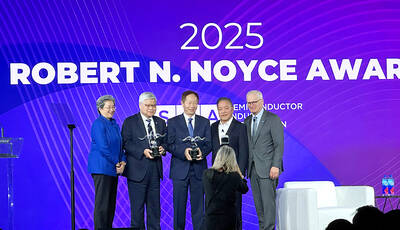Circulation is dropping, print advertising revenue is falling and readers are going online to get news for free, leaving the US newspaper industry awash in red ink and threatening some of the biggest names in journalism.
“The business model that used to work at newspapers does not work any more,” the Washington Post Co chairman Donald Graham said last week, echoing what many observers of the US media landscape have been saying for some time.
With The Tribune Co, owner of the Los Angeles Times and other newspapers, seeking bankruptcy protection and vultures circling around other publications, comedian Jon Stewart got into the act with a new punchline to an old joke.
“What’s black and white and completely over?” Stewart asked viewers of his popular mock news television show on Comedy Central.
“Newspapers!” he said.
The crisis gripping the industry is of course no laughing matter to the 15,422 newspaper employees who have been laid off this year or taken buyouts, according to figures compiled by Erica Smith, a St. Louis Post-Dispatch journalist who tracks the cuts on her blog.
Media job losses are also being updated several times a day on a feed on micro-blogging service Twitter started last month by a group of public relations agents called The Media Is Dying.
Not a day goes by without more bad news for the newspaper industry as the financial slowdown accelerates the decline in print advertising revenue and more classified advertisers turn to free Web sites such as Craigslist.com.
The Audit Bureau of Circulations said that circulation for 507 daily US newspapers fell 4.64 percent in the six months to September to 38.16 million copies from 40.02 million in the same period last year.
Only Gannett Co’s USA Today and Rupert Murdoch’s Wall Street Journal bucked the trend, posting marginal gains of 0.01 percent in readership.
Print and online newspaper advertising revenue fell by 18.1 percent in the third quarter of the year, said the Newspaper Association of America, the sixth quarter in a row of decline.
Overall online ad spending, while increasing, is forecast to grow by only 8.9 percent next year, eMarketer said, and no major newspaper has reached a point yet where online revenue accounts for even 15 percent of total revenue.
The biggest bombshell yet exploded on the front pages last week with the announcement that the Tribune Co, which owns the Chicago Tribune, Baltimore Sun and Harford Courant in addition to the Los Angeles Times, had filed for bankruptcy protection, suffocating under nearly US$13 billion in debt.
Some newspaper owners argued that the Tribune’s woes were not indicative of the industry as a whole because the company had been purchased by a Chicago real estate magnate in a highly leveraged buyout that left it deep it debt.
But dozens of other newspaper face an uncertain future and Graham, speaking at a conference sponsored by UBS Bank in New York, hit the nail on the head with his assessment that the business model for US newspapers is broken.
“Both the Post and Newsweek will lose money in 2008,” Graham said of his flagship paper and news magazine, and “an extremely difficult climate for advertising will challenge us to demonstrate any improvement at all in 2009.”
Graham has invested heavily in a digital future for the newspaper, pouring resources into the Post Web site and hiring a new digital media officer.
The venerable New York Times has also been seeking to reinvent itself as a multi-media company but tightening credit and dwindling profits forced it this month to mortgage its new headquarters building.
“I think we are going to see some significant communities without daily newspapers in the not too distant future,” warned Roy Peter Clark, a vice president at the Poynter Institute, a journalism think tank.
Speaking at a forum in Naples, Florida, on “The Future of Journalism” sponsored by the National Press Club, Clark added that there was “no magic bullet” to ensure their survival.
In a bid to try to turn things around, the American Press Institute last month invited 50 top US newspaper executives to an event billed as the “CEO Summit on Saving an Industry in Crisis.”
Two corporate turnaround experts warned the assembled executives they were facing a “classic change-or-die scenario” and must act quickly.
One respected newspaper, the 100-year-old Christian Science Monitor, has already given up the fight — in print at least.
The Pulitzer Prize-winning newspaper announced in October that it plans to end its daily print edition in April and become the first national US newspaper to publish only on the Internet.

Shiina Ito has had fewer Chinese customers at her Tokyo jewelry shop since Beijing issued a travel warning in the wake of a diplomatic spat, but she said she was not concerned. A souring of Tokyo-Beijing relations this month, following remarks by Japanese Prime Minister Sanae Takaichi about Taiwan, has fueled concerns about the impact on the ritzy boutiques, noodle joints and hotels where holidaymakers spend their cash. However, businesses in Tokyo largely shrugged off any anxiety. “Since there are fewer Chinese customers, it’s become a bit easier for Japanese shoppers to visit, so our sales haven’t really dropped,” Ito

The number of Taiwanese working in the US rose to a record high of 137,000 last year, driven largely by Taiwan Semiconductor Manufacturing Co’s (TSMC, 台積電) rapid overseas expansion, according to government data released yesterday. A total of 666,000 Taiwanese nationals were employed abroad last year, an increase of 45,000 from 2023 and the highest level since the COVID-19 pandemic, data from the Directorate-General of Budget, Accounting and Statistics (DGBAS) showed. Overseas employment had steadily increased between 2009 and 2019, peaking at 739,000, before plunging to 319,000 in 2021 amid US-China trade tensions, global supply chain shifts, reshoring by Taiwanese companies and

Taiwan Semiconductor Manufacturing Co (TSMC) Chairman C.C. Wei (魏哲家) and the company’s former chairman, Mark Liu (劉德音), both received the Robert N. Noyce Award -- the semiconductor industry’s highest honor -- in San Jose, California, on Thursday (local time). Speaking at the award event, Liu, who retired last year, expressed gratitude to his wife, his dissertation advisor at the University of California, Berkeley, his supervisors at AT&T Bell Laboratories -- where he worked on optical fiber communication systems before joining TSMC, TSMC partners, and industry colleagues. Liu said that working alongside TSMC

TECHNOLOGY DAY: The Taiwanese firm is also setting up a joint venture with Alphabet Inc on robots and plans to establish a firm in Japan to produce Model A EVs Manufacturing giant Hon Hai Precision Industry Co (鴻海精密) yesterday announced a collaboration with ChatGPT developer OpenAI to build next-generation artificial intelligence (AI) infrastructure and strengthen its local supply chain in the US to accelerate the deployment of advanced AI systems. Building such an infrastructure in the US is crucial for strengthening local supply chains and supporting the US in maintaining its leading position in the AI domain, Hon Hai said in a statement. Through the collaboration, OpenAI would share its insights into emerging hardware needs in the AI industry with Hon Hai to support the company’s design and development work, as well